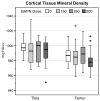Bone fracture toughness and strength correlate with collagen cross-link maturity in a dose-controlled lathyrism mouse model
- PMID: 25213475
- PMCID: PMC4333018
- DOI: 10.1002/jbmr.2356
Bone fracture toughness and strength correlate with collagen cross-link maturity in a dose-controlled lathyrism mouse model
Abstract
Collagen cross-linking is altered in many diseases of bone, and enzymatic collagen cross-links are important to bone quality, as evidenced by losses of strength after lysyl oxidase inhibition (lathyrism). We hypothesized that cross-links also contribute directly to bone fracture toughness. A mouse model of lathyrism using subcutaneous injection of up to 500 mg/kg β-aminopropionitrile (BAPN) was developed and characterized (60 animals across 4 dosage groups). Three weeks of 150 or 350 mg/kg BAPN treatment in young, growing mice significantly reduced cortical bone fracture toughness, strength, and pyridinoline cross-link content. Ratios reflecting relative cross-link maturity were positive regressors of fracture toughness (HP/[DHLNL + HLNL] r(2) = 0.208, p < 0.05; [HP + LP]/[DHNL + HLNL] r(2) = 0.196, p < 0.1), whereas quantities of mature pyridinoline cross-links were significant positive regressors of tissue strength (lysyl pyridinoline r(2) = 0.159, p = 0.014; hydroxylysyl pyridinoline r(2) = 0.112, p < 0.05). Immature and pyrrole cross-links, which were not significantly reduced by BAPN, did not correlate with mechanical properties. The effect of BAPN treatment on mechanical properties was dose specific, with the greatest impact found at the intermediate (350 mg/kg) dose. Calcein labeling was used to define locations of new bone formation, allowing for the identification of regions of normally cross-linked (preexisting) and BAPN-treated (newly formed, cross-link-deficient) bone. Raman spectroscopy revealed spatial differences attributable to relative tissue age and effects of cross-link inhibition. Newly deposited tissues had lower mineral/matrix, carbonate/phosphate, and Amide I cross-link (matrix maturity) ratios compared with preexisting tissues. BAPN treatment did not affect mineral measures but significantly increased the cross-link (matrix maturity) ratio compared with newly formed control tissue. Our study reveals that spatially localized effects of short-term BAPN cross-link inhibition can alter the whole-bone collagen cross-link profile to a measureable degree, and this cross-link profile correlates with bone fracture toughness and strength. Thus, cross-link profile perturbations associated with bone disease may provide insight into bone mechanical quality and fracture risk.
Keywords: BIOMECHANICS; COLLAGEN CROSS-LINKS; FRACTURE TOUGHNESS; RAMAN SPECTROSCOPY; β-AMINOPROPIONITRILE (BAPN).
© 2014 American Society for Bone and Mineral Research.
Conflict of interest statement
That authors state that they have no conflicts of interest.
Authors’ roles: Study design: EM and DK. Study conduct: EM. Data collection: EM and BG. Data analysis: EM and BG. Data interpretation: EM, BG, MM, DK. Drafting manuscript: EM. Revising manuscript content: EM and DK. Approving final version of manuscript: EM, BG, MM, and DK. EM and DK take responsibility for the integrity of the data analysis.
Figures






Similar articles
-
Exercise increases pyridinoline cross-linking and counters the mechanical effects of concurrent lathyrogenic treatment.Bone. 2015 Dec;81:327-337. doi: 10.1016/j.bone.2015.07.030. Epub 2015 Jul 23. Bone. 2015. PMID: 26211995 Free PMC article.
-
Lathyrism-induced alterations in collagen cross-links influence the mechanical properties of bone material without affecting the mineral.Bone. 2011 Dec;49(6):1232-41. doi: 10.1016/j.bone.2011.08.027. Epub 2011 Sep 2. Bone. 2011. PMID: 21920485 Free PMC article.
-
Collagen cross-link profiles and mineral are different between the mandible and femur with site specific response to perturbed collagen.Bone Rep. 2022 Oct 19;17:101629. doi: 10.1016/j.bonr.2022.101629. eCollection 2022 Dec. Bone Rep. 2022. PMID: 36325166 Free PMC article.
-
Collagen cross-links in mineralizing tissues: a review of their chemistry, function, and clinical relevance.Bone. 1998 Mar;22(3):181-7. doi: 10.1016/s8756-3282(97)00279-2. Bone. 1998. PMID: 9514209 Review.
-
Collagen cross-links as a determinant of bone quality: a possible explanation for bone fragility in aging, osteoporosis, and diabetes mellitus.Osteoporos Int. 2010 Feb;21(2):195-214. doi: 10.1007/s00198-009-1066-z. Osteoporos Int. 2010. PMID: 19760059 Review.
Cited by
-
The Role of Water Compartments in the Material Properties of Cortical Bone.Calcif Tissue Int. 2015 Sep;97(3):292-307. doi: 10.1007/s00223-015-9977-5. Epub 2015 Mar 18. Calcif Tissue Int. 2015. PMID: 25783011 Free PMC article. Review.
-
External bone size identifies different strength-decline trajectories for the male human femora.J Struct Biol. 2020 Dec 1;212(3):107650. doi: 10.1016/j.jsb.2020.107650. Epub 2020 Oct 21. J Struct Biol. 2020. PMID: 33096230 Free PMC article.
-
Characterization of the Biological Fingerprint and Identification of Associated Parameters in Stress Fractures by FTIR Spectroscopy.Biomed Res Int. 2019 Sep 22;2019:1241452. doi: 10.1155/2019/1241452. eCollection 2019. Biomed Res Int. 2019. PMID: 31662967 Free PMC article.
-
Radiation-induced changes to bone composition extend beyond periosteal bone.Bone Rep. 2020 Mar 28;12:100262. doi: 10.1016/j.bonr.2020.100262. eCollection 2020 Jun. Bone Rep. 2020. PMID: 32258252 Free PMC article.
-
Fkbp10 Deletion in Osteoblasts Leads to Qualitative Defects in Bone.J Bone Miner Res. 2017 Jun;32(6):1354-1367. doi: 10.1002/jbmr.3108. Epub 2017 Mar 20. J Bone Miner Res. 2017. PMID: 28206698 Free PMC article.
References
-
- Saito M, Marumo K. Collagen cross-links as a determinant of bone quality: a possible explanation for bone fragility in aging, osteoporosis, and diabetes mellitus. Osteoporos Int. 2010;21(2):195–214. - PubMed
-
- Viguet-Carrin S, Garnero P, Delmas PD. The role of collagen in bone strength. Osteoporos Int. 2006;17(3):319–36. - PubMed
-
- Burr DB, Turner CH. Biomechanics of Bone. In: Favus M, editor. Primer on the metabolic bone diseases and disorders of mineral metabolism. 5. Washington DC: American Society for Bone and Mineral Research; 2003. pp. 58–64.
-
- Reilly DT, Burstein AH. Review article. The mechanical properties of cortical bone. J Bone Joint Surg Am. 1974;56(5):1001–22. - PubMed
Publication types
MeSH terms
Substances
Grants and funding
LinkOut - more resources
Full Text Sources
Other Literature Sources
Medical
Research Materials
Miscellaneous

